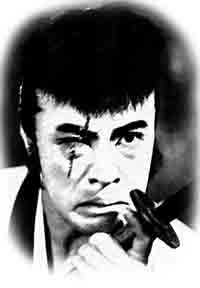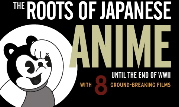The title of Matsue Tetsuaki’s music
documentary, Live Tape (Raibu tēpu), which won the best picture award in the Japanese Eyes section of the 2009 Tokyo International
Film Festival, is both anachronistic and a contradiction in terms.
First it is anachronistic because these
days few people use tape to record either music or video anymore. Recording on
a hard disk is the norm for pros, which means that there are few material
restrictions on how much you record. Tape, however, even if it is digital,
limits you to the length of the tape, and that’s what’s emphasized here, as
Matsue daringly decided to video tape a folk musician, Maeno Kenta, walking and
singing through Kichijōji on New Year’s Day 2009 in a single, 74-minute shot
that just fits into the length of a tape. No cuts, no trickery. Using tape is kind
of old-fashioned, but so also is the belief in the spatiotemporal integrity of
the shot in these days of digital manipulation. Matsue, who has insisted on a
kind of - should we call it “outmoded”? - personal realism in his documentaries
(Annyong Kimchi [1999], The Virgin Wildsides [Dōtei o purodusu, 2007], or Annyeong Yumika [2009)) and his AV work, stubbornly
persists in letting reality, from technical issues to real events, limit the
image, instead of conquering it all through the computer.
Adhering to an indexical relation to
reality using digital tape may also be contradictory, but more so is the notion
that whatever is taped is live. This is the central problem of any concert
documentary: it tries to capture the spatial and temporal singularity of a live
performance, the fact that anything can happen here and now and never be altered or
experienced again, but using a medium that is reproducible, open to
manipulation, and always somewhat after the fact, taking place somewhere else.
Most music documentaries utterly ignore this problem. Aoyama Shinji’s Ajima no
uta (2003), which I wrote about in Okinawa ni tachisukumu, does not, but it does so
more conceptually, undermining the “liveness” of the concert footage of
Uehara Tomoko by emphasizing the “liveness” of recording in the studio,
focusing on the “mistakes” there - both in the music and the film - that are
usually edited out. While acknowledging the impossibility of presenting the
“live” in film, Aoyama paradoxically suggests it by foregrounding the limits of
“liveness.”
Matsue’s approach to the problem is much
less conceptual. In fact, he seems to still think he can force video tape to be
“live” through sheer material tour de force. Catching Maeno outside a shrine
full of hatsumōde visitors, Matsue follows him through the streets and alleys
of Kichijōji as he plays tune after tune - and occasionally talks to the camera
- until he ends up at Inokashira Park. Along the way, he encounters several
musicians, with whom he plays duets, and ends up in a
mini-concert at the park band shell. It is a clearly planned occurrence, but it
is one that lives off of “live” chance. Like a live show, it can’t be done over
again, even if there is a mistake - the one shot makes it too big an
undertaking and the New Year’s events too temporally specific to do that. The
tension is thus palpable, and we eagerly wait for some accident to happen.
Nothing big does (especially at the usually narratively pleasing end) - which
paradoxically may make it more real - but the small occurrences, such as
passersby hesitating over whether to cross in front of the camera or not,
approximate the pleasures of a live performance.
Of course, part of the pleasure is also in
the narrative itself. This can mean the single, but meandering line of walking
through Kichijōji (which is fun to watch if you’ve been there before), but it
can also involve the spectacle of the planned (the musicians) appearing within
the other chance encounters. The central drama is the conflict between Matsue
and Maeno, as the former, mostly off-screen, urges Maeno to put more energy
into it or criticizes him for not following the plan (dandori), and the latter
purposely resists Matsue’s control (e.g., by donning another pair of sunglasses
after he, according to the script, gave away the first one). Such conflict was
certainly part of the plan, but it was also Matsue’s effort to ensure that some
live happenings invaded his tape.
Beyond the stance towards reality and
documentary, there is also something ritualistic about all this. Starting with
a girl (Nagasawa Tsugumi) praying at a shrine, Live Tape can also be Matsue’s
prayer for life. Apparently planned at the last instant, as Matsue decided he
wanted to do something other than laze around on New Year’s after a year when
his father and grandmother died, the video adds extra meaning to the “live” in
“Live Tape.”
One is still left with doubts over whether
Matsue’s physical effort to force live reality onto tape really works in this
digital age. And Matsue’s respect for the music, which translates into a
practice that not only asks us to experience each song from start to finish in
a single, integral temporality, also works with multiple mikes to create a
sound that can seem too clear to be true. The visuals may approach the live,
but the sound may not.
But in foregrounding his own contradictory
and anachronistic stance in the title, Matsue seems to accept that Live Tape is
not perfect. That this is part of the reality we should accept and not control
or perfect. It may be “outmoded,”
but it reminds us our digital world has not controlled reality as much as it
pretends.
And I think many of us still hope it does
not. I for one, perhaps in order to tap into Live Tape’s reality, have jumped
on to its temporal bandwagon. This was all written on New Year’s Day, after
going to hatsumōde, exactly one year after Matsue’s live event.


